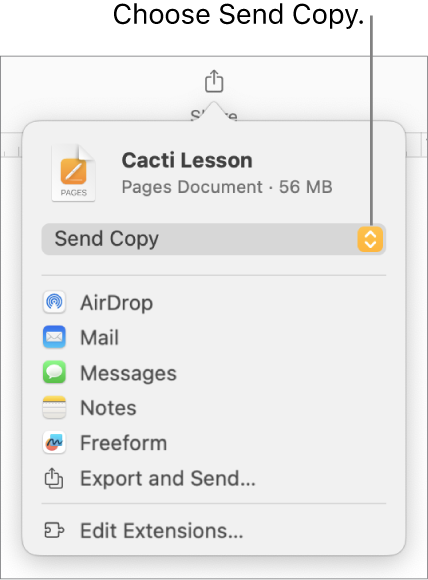
Send a document in Pages on Mac
You can send a copy of a document using AirDrop, Mail, Messages, or another service. You can also send a copy in another format such as PDF, Word, EPUB, Plain Text, or RTF.
Tip: Before you send a copy of your document to a recipient, you can lock it to prevent anyone from modifying the copy or password-protect it to restrict access to the document and provide extra security.
Send a copy of a Pages document
With the document open, do one of the following:
macOS Ventura 13 or later: Click Share
 in the toolbar, click the pop-up menu, then choose Send Copy.
in the toolbar, click the pop-up menu, then choose Send Copy.
Note: If you have not saved the document yet, you will be asked to do so before you can share it.
macOS 12 or earlier: Choose File > Send a Copy (from the File menu at the top of your screen).
To select how you want to send the document. click one of the following:
AirDrop: Click the name of the recipient. The recipient must be on the same network and must accept the file to receive it.
Mail or Messages: Type an email address or phone number for each recipient, add a note if you want, then click Send (for Mail) or press Enter (for Messages).
Notes: To save a copy in the Notes app, choose the note where you want to save it (or create a new one), add text if you want, then click Save.
Send a copy of a Pages document in another format
With the document open, do one of the following:
macOS Ventura 13 or later: Click Share
 in the toolbar, then click Export and Send.
in the toolbar, then click Export and Send.macOS 12 or earlier: Choose File > Send a Copy (from the File menu at the top of your screen), then click how you want to send the document.
Select a format for the copy, then specify the settings you want to use:
PDF: You can open and sometimes edit these files with applications like Preview and Adobe Acrobat. Click the Image Quality pop-up menu, then choose an option (the higher the image quality, the larger the file size). If you added image, drawing, audio, or video descriptions for assistive technology (for example, VoiceOver), they’re automatically exported. To include smart annotations or comments, select the corresponding checkbox. To include accessibility tags for large tables, click Advanced Options, then choose On in the Accessibility pop-up.
Word: These files can be opened and edited with Microsoft Word in .docx format.
EPUB: Use this format to make your document readable in an ebook reader (such as Apple Books). Enter the title and author name, then choose a cover option.
For word-processing documents only, choose a layout type. A fixed layout preserves the layout of your document and is best for documents with multiple columns or lots of images. A reflowable layout adapts to the screen size and orientation and lets users change the font size. It’s best for documents with lots of text.
To set optional features, click the disclosure arrow next to Advanced Options, then choose a category, specify the document’s language, set the view to one page or two pages, and choose whether or not to include the table of contents or embed fonts.
Plain Text (TXT): Use this format to export body text as unformatted text. Text boxes, shapes, images, lines, tables, and charts aren’t exported. Page layout documents can’t be exported in TXT format.
Tip: To see if you have a word-processing or page layout document, click
 in the toolbar. If there’s a Bookmarks tab at the top of the sidebar, it’s a word-processing document.
in the toolbar. If there’s a Bookmarks tab at the top of the sidebar, it’s a word-processing document.Rich Text Format (RTF): You can export body text and tables as formatted (RTF) text and tables. If the document has text boxes, shapes, lines, and charts that can be exported, they’re exported as images, and the document is exported in RTFD format. You may not be able to open an RTFD file with applications other than Pages and TextEdit. You can’t export page layout documents in RTF or RTFD format.
Pages ’09: You can open this format with Pages 4.0 through 4.3 on a Mac.
If there’s a password checkbox, do one of the following:
Set a password: Select the “Require password to open” checkbox, then enter a password. It applies only to the exported copy.
Keep the original document password: Make sure the “Require password to open” checkbox is selected.
Use a different password for the exported copy: Select the password checkbox, click Change Password, then set a new password.
Export the copy without a password: Deselect the “Require password to open” checkbox.
Click Send a Copy in the bottom-right of the controls, then choose a sending option:
Mail or Messages: Type an email address or phone number for each recipient, add a note if you want, then click Send (for Mail) or press Enter (for Messages).
AirDrop: Click the name of the recipient. The recipient must be on the same network and must accept the file to receive it.
Notes: To save a copy in the Notes app, choose the note where you want to save it (or create a new one), add text if you want, then click Save.
To make it easier to send, post, or share your document, you can reduce its file size.
